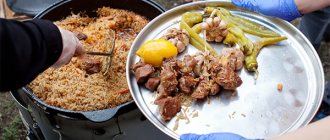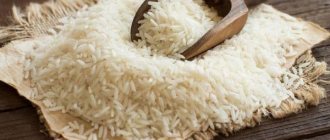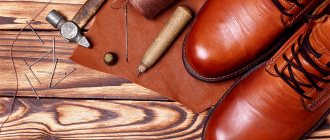Reviews (2)
8
Updated: Dasha Petrova
04/24/2017 Cooking time: 1 hour 10 minutes
| Save | I cooked) | Estimate |
I'll tell you how to cook pilaf from steamed rice with pork. Of course, you have probably cooked pilaf more than once; each housewife has her own personal recipe. And I’m happy to share mine. You'll like it!
Steamed or polished
Experienced chefs know what makes pilaf successful. It's about choosing the right rice. Considering the variety of this cereal on store shelves, it is worth learning to understand its varieties, types and quality.
Steamed and polished have already undergone certain processing to improve taste. But are both suitable for preparing oriental dishes? Steamed or heat-treated rice is the best for many cooks; it has a crumbly structure and absorbs moisture well. The prepared food comes in large quantities and is rich in vitamins.
Polished grains are rarely purchased for pilaf, since after deep processing they acquire a smooth shape, translucent, white color, vitamins and microelements are practically absent. It is better to use this product for preparing viscous porridges.
Features of steamed rice
On store shelves you can find two varieties of rice grains of different sizes and shapes: polished or steamed. The last type undergoes special processing before sale. First, it is filled with water, removing starch, which often causes the porridge to stick together. Next, the cereal is doused with high-temperature steam. As a result, the grains acquire a golden hue and a transparent structure, as can be seen in the photo. During the cooking process, this rice retains its shape and the grains do not stick together.
Which rice to choose for pilaf
This question is asked by many inexperienced housewives. Sometimes you can find the inscription “for pilaf” on the packs, but often this is just a marketing ploy. The price/quality ratio is not always justified. Quite expensive varieties are often counterfeited by coloring ordinary rice. This is easy to check: if the water turns colored during soaking, it means you purchased a fake. Also, the Chinese have long learned to mix synthetic resins with starch, from which they form grains.
The main requirements for cereals for pilaf are: hardness, ribbed structure, grain integrity - a high-quality cereal will not break, burn in dishes, have a clearly different yellowed or white appearance, stick together, and must absorb water, aromas of seasonings and fats well.
To prepare oriental food, today it is better not to use crushed, finely polished cereals, because they contain a lot of starch. When cooked, the grains stick together and swell. But Soviet housewives could not afford to often buy high-quality imported cereals and resorted to a little trick - first they fried ordinary cheap rice in oil. With this method, the starch is “sealed” in it, and the grains do not lose their shape.
Devzira is the best long-grain variety, but also the most expensive, which can expand seven times during heat treatment, perfectly absorbs aromas, and always turns out crumbly. It was created specifically for pilaf, bred by breeders. The cereal has a pleasant beige color, a sweetish taste, and contains almost no starch. Preparing a real tasty oriental side dish from devzira is not difficult. A characteristic feature is its weightiness.
A few recommendations for delicious pilaf
Knowing how to properly make a side dish is quite important. But this is not all that is needed to make real pilaf that your family and friends will admire. Here are some more useful tips that will certainly be very useful to you:
- Some chefs use beef to make pilaf. But this is not the best choice, since the dish turns out too dry. It is much better to take beef or pork. Chicken is also allowed if that's your preference.
- The oil used is important. Uzbeks always take two - cotton and sesame, and also always add fat tail fat. This results in a richer aroma.
- To ensure a successful pilaf, it is recommended to use a cast iron, copper or aluminum cauldron. This may seem unusual, but the material of the cookware has a great influence on the taste of the dish.
These tips can help you make the perfect pilaf that has amazing texture and flavor. Stick to them, and you can please your family with an incredibly tasty dish, using the cheapest grains and spending a minimum amount of time and effort.
So, rice should definitely be soaked. The purpose of washing and soaking grains is well known: the grain is cleared of unnecessary starch, acquires an interesting shade, becomes crumbly and makes the taste of the dish more vibrant and appetizing. The suitable temperature for soaking in water is 60 C. Steamed rice grains can also be soaked, but this is not necessary. In addition to everything, you need to wash any grains. First, this is used for hygienic purposes - to clean dust, dirt and possible chemicals. substances.
pexels
Brown
Brown or brown cereal has many advantages: unusual taste, low calorie content, and a minimum of starch contained in it. It consists of unpolished cereals that are minimally processed and retain a greater amount of beneficial microelements. The grains have a slightly nutty aroma that lingers during cooking due to the bran shell. They contain amino acids, proteins, essential dietary fiber, B vitamins, and minerals. When consuming the product, the body receives slow carbohydrates, which take a long time to be consumed, and hunger occurs much later than usual.
The disadvantages are the high cost and short shelf life.
The most popular brown rice is indica. This variety undergoes very careful processing and preserves the embryos that are beneficial to the human body. When sprouted, high-quality grains always sprout.
Preparation
It would be wrong to pour rice into the zirvak without preparation. To make pilaf and not porridge with meat, the rice needs to be prepared.
Do not use a colander to soak rice
How to soak
It is necessary to wash the rice. This is to remove starch powder, which will turn into a paste in the finished dish. In addition, there may be dust, chemicals and other nasty things on the surface of the cereal.
Long grain rice varieties are easy to break when washed. It's better not to interfere with your hands at all, let running water do all the work. And only when this is not enough, is it permissible to stick your palm under the rice and stir it to help wash it.
Do not rub the rice between your palms when washing.
You need to rinse until you get clean water. Completely clean.
After proper washing, the cereal needs to be soaked. so that it takes in water and cooks in the pilaf not for too long.
Many people are interested in: how long to soak? In soft varieties of rice, saturation can occur in thirty minutes, in hard varieties (devzira, basmati) - in about two hours.
When soaked, rice that has absorbed water will absorb less fat, and the pilaf will be lighter. Do not over-soak it in water, otherwise the rice will cook in the pilaf too quickly. The ability to determine when rice has received enough water will come with experience.
What kind of water to fill
Dry cereal quickly absorbs any water. We recommend not soaking in tap water, but using salted drinking water - this will improve the taste. Use warm salted water in a 3:1 ratio to rice.
Take tasty water - the rice will absorb it and this will affect the taste of the pilaf. A little, but it will have an impact.
The water temperature is no more than 60 degrees Celsius. Add 2 tablespoons of salt to 3 liters of water.
If you fill it with rice, you feel that the water smells bad - change it.
Is it worth frying?
Yes, this method of preparing rice for pilaf exists. The rice is not washed, but fried, which causes some of the starch and powder to caramelize, and more of the B vitamins contained in the grain shell are retained. They are prepared only from rice, not of glassy varieties, but of chalky varieties, which are highly boiled and have a low coefficient of water absorption. In a cauldron with a spherical bottom, put a tablespoon of melted butter per 1 kilogram of rice; when it melts, add the rice and fry, stirring constantly with a slotted spoon, until it acquires a pinkish tint. When using fried rice, you need to add more water to the pilaf.
Read also Trees and shrubs of Crimea names and photos
White
White polished rice is familiar to everyone since childhood. It is the cheapest, but stores well. You can quickly cook porridge from it (in about 15 minutes). But in terms of health benefits, it is significantly inferior to brown rice - white rice does not have a bran shell. The shapes are divided into long-grain (practically does not stick together), medium-grain (becomes soft), round (quickly sticks together). But there are varieties of white cereals that are well suited for pilaf. Among the best white grains for pilaf are Basmati (long-grain, with proper preparation the volume doubles, the product turns out crumbly), Arborio (medium-grain, round-grain, remarkably absorbs the odors of spices and meat), Krasnodar (round, slightly elongated), Jasmine (does not boil and does not stick together).
What is better to take: water or broth?
Even if the pilaf is meat, most often it is cooked in water . Meat and vegetables are fried inside the cauldron, then rice is sent there, and finally boiling water is poured in.
After this, the dish is brought to a boil over high heat (so that the starch inside each grain of rice “grabs” these grains, but does not turn everything into solid jelly). The heat is reduced to a minimum, the vessel is covered with a lid and the pilaf is evaporated until cooked.
Important point! Turn off the heat when the rice is still slightly firm (al dente). It is better to wrap the pan or cauldron or simply leave it with a lid, allowing the dish to cook for 30-60 minutes.
Krasnodar
The most fluffy rice is long grain rice. Despite the fact that Krasnodar rice is a soft variety, there are cereals containing large amounts of amylose. Thanks to it, the rice keeps its shape perfectly during cooking. These varieties include Flagman, Regul, Khazar, Rapan. They contain up to 25% amylose.
In order for the side dish of Krasnodar rice to turn out “as it should,” certain culinary rules must be followed. First you need to rinse the rice until the water is clear, dry it in a colander and pour it into a saucepan with a thick bottom. Add a tablespoon of oil and, stirring, keep on fire for 1-2 minutes. Pour 3 cups of boiling water over the product and cook for 20 minutes over low heat, adding salt 5 minutes before it’s ready. Boil, drain again and rinse. After this, add oil to the side dish. The result is an elastic, slightly sweet and soft product.
What you need for cooking
If we consider the version of Uzbek pilaf, which is traditionally prepared from long-grain rice, then it will require the following products:
- vegetable oil – 100–150 ml (the classic recipe uses cottonseed oil);
- steamed rice – 500 g;
- lamb – 500 g;
- carrots – 3 pcs.;
- onions – 2–3 pcs.;
- garlic – 1 whole head;
- spices: hot pepper and cumin;
- salt;
- bay leaf (optional).
In fact, there is no standard pilaf recipe that you need to follow. Different countries prepare this dish in their own way. For example, we often cook it with pork, whereas in oriental cuisine this meat is not present at all. There, young mutton (lamb) or beef is used for pilaf. In Tatar cuisine, pilaf is prepared with chicken, and with beef or lamb, of course.
There is also no standard set of spices. It is hardly possible to imagine pilaf without some pepper. This product can be ground, in the form of peas, a mixture of peppers, it is also good to use hot peppers in a pod. To give the pilaf a spicy taste, cumin (cumin) is added, turmeric is added for a beautiful color, and dried barberry is added for a rich taste and aroma.
If you want to make the taste of the dish softer and sweeter, add raisins or dried apricots.
You can also find prunes in many recipes. In general, you can experiment with a set of products for pilaf. Only 4 ingredients remain unchanged: rice, meat, onions and carrots. The rest of the products are a matter of taste and preference.
What else is required to prepare good pilaf is a cauldron with a thick bottom and walls. If pilaf is often on your table, then you definitely need to get such utensils. A more modern option is also suitable - a wok frying pan, which looks very similar to a cauldron, in which it is customary to cook a dish in Asian countries, or an ordinary wide frying pan with a non-stick coating.
Long or round
Many professional cooks prefer round rice, believing that it makes pilaf more juicy and tasty. It can be prepared in a pressure cooker, slow cooker and on the stove. Do not stir the finished side dish.
For someone who is not an expert in preparing oriental cuisine, it is easier to take a long one, as it will be more difficult to digest. It comes in white, brown and black. But mostly they use white and steamed. Cooking time is about half an hour. If long grain rice is washed well, the pilaf will definitely turn out crumbly.
Questions and answers
How to cook pilaf with regular round rice?
If there is no other rice other than round rice, and you really want to cook pilaf, you should rinse the grains very thoroughly to get rid of excess starch. You can additionally dry the rice and then fry it in a frying pan in vegetable oil (so that it becomes crumbly). It should be taken into account that round cereals boil quickly. To prevent the grains from falling apart after adding rice, cook the pilaf for no longer than 10-15 minutes, without covering it with a lid. You can cover the dish after the heat is turned off so that the grains are ready and well saturated with flavors and aromas.
Relation to water
The question often arises of how much water should be used to prepare pilaf. After all, it depends on how the dish turns out - tasty and crumbly, or dry or wet, like porridge. How much water to add to pilaf depends on the method of its preparation. For example, for traditional Azerbaijani pilaf, all ingredients are boiled and cooked separately, after which they are mixed in a cauldron. This method of preparation requires 3 times more water than the main product. For Uzbek-style pilaf, all products are added one at a time and cooked together. The cereal is poured with boiling water at the rate of 1 to 2.5. The simplest solution would be to take the amount of water that will cover the rice and meat by 2 cm.
How else is it possible to cook
Delicious pilaf can be prepared not only in a cauldron, but also in a slow cooker. If your “assistant” has the corresponding function, then the steamed rice will show its best qualities, become quite soft and at the same time will not lose its crispness. The ingredients for the dish are listed above, but if you want to cook pilaf without first stewing the meat, then it is more advisable to use poultry - it is cooked at the same time as the rice.
Delicious recipe! Sweet peppers in sweet marinade
To immediately put all the products into the multicooker, prepare them in advance: rinse the rice, peel and chop the onions and carrots, cut the meat into small pieces and fry if the recipe requires it. You can fry vegetables and meat immediately in the multicooker bowl, after which all that remains is to add rice, spices and add water.
If only a multicooker is used to prepare pilaf, then the process will look like this:
- Fry the meat in the “fry” mode for 10 minutes.
- Add chopped vegetables to the meat (onion in half rings, carrots in strips), and fry in the same mode for another 5 minutes.
- Add spices, salt, garlic, a couple of glasses of water to the multicooker bowl, and turn on the “stew” mode for 20 minutes.
- Then add rice and add enough water to cover all the ingredients by 1-1.5 cm. We put the machine on the “cook” mode for 40 minutes. The set of functions differs in different multicookers; yours may have a “rice” or “pilaf” mode.
- After cooking the pilaf, do not open it, but let it stand for 15 minutes. Then stir and serve with fresh vegetables and herbs.
You can prepare different versions of pilaf from steamed rice: with fish, seafood, mushrooms or vegetables.
The process of preparing such a dish will be slightly different from the classic recipe with meat. It should be borne in mind that vegetables and mushrooms cook quickly, while fish and seafood only need a short steam treatment. Therefore, it is better to first cook the rice with fried carrots and onions until half cooked, and then add the rest of the ingredients. In general, experiment and don’t doubt your success. Bon appetit!
Cooking pilaf often confuses housewives, because not everyone can make a crumbly, appetizing oriental dish. To ensure that the pilaf comes out as it should and does not resemble a sticky porridge, use steamed rice for cooking. This cereal has a denser shell, so your chances of getting real pilaf increase significantly. Chefs recommend using long-grain steamed rice; it will successfully replace expensive Asian varieties.
Why does it turn out like porridge?
To make the pilaf really tasty, you shouldn’t rush during cooking. Often it can turn out sticky, like porridge, and several reasons can contribute to this. Starchy rice was originally intended to be sticky, making it suitable for dishes such as risotto. If the grains were poorly washed, a lot of starch will remain on them, due to which the grains stick together. Lack of soaking of certain varieties leads to soggy and sticky
An important condition is the correct cooking time. Overcook the cereal and you end up with porridge. This also applies to carrots in pilaf.
If you notice that there is too much water and the grains are already cooked, it is better to turn off the heat and cover the dish with a lid. Water, if there is not a lot of it, will be absorbed. If there is too much water, you will have to evaporate it, but the end result will be a regular tasty porridge.
You can also add a small amount of fat and try drying it by frying it in a frying pan or in the microwave. Fat separates the grains from each other. But the dish will turn out to be quite fatty, so this method is not suitable for people with gastrointestinal problems.
If it didn't work out
So, what you feared happened: it turned out to be tasty, but a porridge with meat. There is nothing that can be done to correct anything at this point. But you need to draw conclusions and not give up culinary experiments.
The rice in the pilaf may stick together, or, on the contrary, it may be dry.
Why does it turn out like porridge?
Pilaf turns into mush for several reasons. Rice grains lose their shape:
- More water than necessary. For example, rice was soaked longer than necessary or excess water was poured into the pilaf.
- The pilaf was overcooked.
- The rice was originally crushed. Or, when washing, long grain rice was broken by rubbing it between the palms.
- Poor quality washing of rice, and rice powder got into the pilaf.
- Starchy variety. Here, either refuse such rice or try to fry it before preparing pilaf.
- We disturbed the pilaf with a slotted spoon, and the cooked rice crumbs fell into the broth and thickened the pilaf.
- And a common, common mistake: the recipe is violated, the proportions and temperature conditions are not followed.
If you are unsure of your abilities, but want to cook pilaf, we recommend starting with steamed rice - it is difficult to make it sticky.
The pilaf turned out dry
There are several reasons why pilaf turns out dry. If there is a lack of water, fat, or vegetable oil, long rice may boil but remain dry. A small amount of vegetables can cause a spoiled side dish, because they are what give it its juiciness. If the dish is removed from the stove at the wrong time, it can also become dry. High heat will evaporate water quickly, so it's best to cook over moderate heat.
It is important to remember certain rules when cooking pilaf: boiling water should be 2.5 cm higher than the grain in the pan. Vegetables should be added as much as possible, approximately 2 times the amount of grains per serving.
If the food still turns out dry, you should try to save the situation. The first way is to fry the onion and mix it with meat broth, then mix with the side dish and leave for 20-30 minutes. You can add the broth to the already prepared pilaf and keep it on low heat. If you don’t have time to cook the broth, plain clean water will do. But you need to make sure that there is not too much liquid, otherwise the dry pilaf will turn into porridge. Enterprising housewives add a little oil to the finished product (but it will be a little fatty), sauce and water (the taste of the food will change slightly).
How long
Having soaked the cereal overnight (for 7-8 hours), in the morning it will definitely be ready for making pilaf. But the hardness of the grains should be taken into account. If they are not completely solid, and they will get wet for a long time, then even before the liquid boils, they will be able to boil. Therefore, this method is only suitable for solid species. Some soft types are saturated after 30 minutes, while other hard ones, for example, devzira and basmati, after a few hours. Over the years, one begins to understand how long each variety needs to be aged.
If you keep the cereal in hot water, only 2 hours is enough, if in cold water – from three hours. It is recommended to soak red rice for 3-5 hours - the boiling time will noticeably decrease. The brown variety of cereal requires a special approach - it is hard, and for cooking it is worth soaking it for 8-12 hours.
pixabay.com
Spices
How much water you need per glass of rice for pilaf is undoubtedly important to know. But there are other secrets. So, every oriental cook knows that the basis of the dish is spices. Ideal for pilaf:
- cumin (cumin);
- hot pepper pods;
- garlic;
- black pepper.
It is better to take sea salt, as it fully reveals the taste of each of the ingredients. If you follow all the cooking rules, the dish should turn out simply unsurpassed. It is prepared with the addition of different types of meat. It can be lamb, pork, beef, chicken and even seafood.
Asian culinary "history"
Rice grains are often used to prepare all kinds of dishes in Asian cuisine. If you want to feed the whole family tasty and satisfying, try making rice using this recipe. Paired with chicken breast, it's a win-win.
On a note! If you are preparing an Asian dish, be sure to add the seasonings specified in the recipe. You can't do without soy sauce. It adds a spicy taste to the dish.
Ingredients:
- fresh frozen chicken breast - one piece;
- soy sauce – two tables. spoons;
- Chinese cabbage – 100 g;
- steamed rice cereal - one glass;
- canned dessert corn – 0.1 kg;
- onion - one head;
- garlic – 1-2 cloves;
- ground red pepper, salt;
- green onion - half a bunch;
- sesame seeds - one handful;
- carrots - 1 root vegetable.
Preparation:
- Let's get straight to the rice grains. To begin with, rinse it thoroughly and boil it in salted water until tender. To improve the taste, add a little butter.
- Peel the onion and garlic cloves. Finely chop them with a knife and place them in a frying pan.
- Sauté these ingredients in a small amount of refined vegetable oil.
- Preparing the chicken breast. We wash the pulp, remove the film and chop it into cubes.
- Add to the pan and fry until the chicken pieces lighten in color.
- We wash and dry the peeled carrot root. Shred on a long grater to make straws. Add chopped carrots to the above ingredients and lightly fry.
- Grind some Chinese cabbage and also add it to the frying pan.
- Mix all ingredients and simmer over low heat. Add ground red pepper.
- Decant the juice from canned dessert corn. Add corn to the pan.
- Next we lay out the boiled rice cereal.
- Mix all ingredients thoroughly and fry for several minutes.
- Add soy sauce.
- Place the prepared dish on a plate.
- Top with white sesame seeds and chopped onions.
Let's summarize
- As a rule, for crumbly pilaf you need to take 2 cups of water for 1 cup of rice.
- This amount of ingredients is relevant for a cauldron and other wide, thick-walled utensils. However, if you cook in a frying pan, pour 3 glasses of water inside, and if you cook in a narrow pan, take no more than a glass.
- To make the rice crumbly, it is better to buy steamed cereal, or fry it in oil/fat.
And you will learn about the intricacies of preparing real Uzbek pilaf, performed by a famous chef, but in your home kitchen, from this video:
When using materials from thebestvideo.ru, a link to the source is required.











